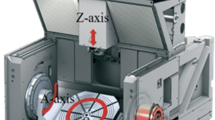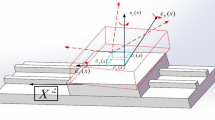Abstract
At present, it is difficult to predict the operation accuracy of machine tools in the preliminary design stage. How to quantitatively reflect the contribution of tolerance on the position error of machine tool has a significant guidance for machine tool design stage. Thus, this paper presents a sensitivity analysis method based on components tolerance, which can clearly give the machine tool designer key the tolerances. Firstly, taking the translational axis as the research object, the operation accuracy model of Y-axis is established based on the homogeneous transform matrix (HTM) and multi-body system (MBS) theory. Meanwhile, the relationship between tolerances and geometric errors has been mapped by the Fourier expansion and the model of parameters have been identified by self-design simulation. As a basis, the tolerance sensitivity analysis (TSA) method based on the single-factor partial derivation is constructed to acquire the key tolerance parameters. Finally, the result of the experiment shows that the assembly tolerance of the Y-Z plane of the base, the manufacturing tolerance of the lead screw and the assembly tolerance of the X-Y plane of the carriage contribute a great deal to the position error, which needs to be strictly controlled in the future design to improve the accuracy of the machine tool.











Similar content being viewed by others
Data availability
The authors confirm that the data supporting the findings of this study are available within the article.
Code availability
The authors confirm that the code supporting the findings of this study are available within the article.
References
Ramesh R, Mannan MA, Poo AN (2000) Error compensation in machine tools — a review: component I: geometric, cutting-force induced and fixture-dependent errors. Int J Mach Tools Manuf 40:1235–1256
Lee JH, Liu Y, Yang SH (2006) Accuracy improvement of miniaturized machine tool: geometric error modeling and compensation. Int J Mach Tools Manuf 46(12–13):1508–1516
Zhong XM, Liu HQ, Mao X, Li B, He S (2019) Influence and error transfer in assembly process of geometric errors of a translational axis on volumetric error in machine tools. Measurement. 140:450–461
Bryan JB (1979) The Abbe principle revisited: an updated interpretation. Precis Eng 1(3):129–132
Tani Y, Katsuki K, Sato H, Kamimura Y (1995) Development of highspeed and high-accuracy straightness measurement of a granite base of a CMM. CIRP Ann—Manuf Technol 44:465–468
Hwang J, Park C-H, Gao W, Kim S-W (2007) A three-probe system for measuring the parallelism and straightness of a pair of rails for ultra-precision guideways. Int J Mach Tools Manuf 47:1053–1058
Ekinci TO, Mayer JRR (2007) Relationship between straightness and angular kinematic errors in machines. Int J Mach Tools Manuf 47:1997–2004
Zha J, Xue F, Chen YL (2017) Straightness error modeling and compensation for gantry type open hydrostatic guideways in grinding machine. Int J Mach Tools Manuf 112:1–6
Tang H, Duan J-a, Zhao Q A systematic approach on analyzing the relationship between straightness & angular errors and guideway surface in precise linear stage. Int J Mach Tools Manuf 120:12–19
Fan et al (2018) Kinematic errors prediction for multi-axis machine tools’ guideways based on tolerance. Int J Adv Manuf Technol 98:1131–1144
Fan K, Wang H, Zhao J, Chang T (2003) Sensitivity analysis of the 3-PRS parallel kinematic spindle platform of a serial-parallel machine tool. Int J Mach Tools Manuf 43(15):1561–1569
Pott A, Kecskeméthy A, Hiller M (2007) A simplified force-based method for the linearization and sensitivity analysis of complex manipulation systems. Mech Mach Theory 42(11):1445–1461
Cheng Q, Zhao HW, Zhang GJ, Gu PH, Cai LG (2014) An analytical approach for crucial geometric errors identification of multi-axis machine tool based on global sensitivity analysis. Int J Adv Manuf Technol 75:107–121
Fan JW, Guan JL, Wang WC, Luo Q, Zhang XL, Wang LY (2002) A universal modeling method for enhancement the volumetric accuracy of CNC machine tools. J Mater Process Technol 129(1):624–628
Tsutsumi M, Saito A (2003) Identification and compensation of systematic deviations componenticular to 5-axis machining centers. Int J Mach Tools Manuf 43(8):771–780
Chen G, Liang Y, Sun Y, Chen W, Wang B (2013) Volumetric error modeling and sensitivity analysis for designing a five-axis ultra-precision machine tool. Int J Adv Manuf Technol 68(9–12):2525–2534
Cui G, Lu Y, Li J, Gao D, Yao Y (2012) Geometric error compensation software system for CNC machine tools based on NC program reconstructing. Int J Adv Manuf Technol 63(1–4):169–180
Wu C, Fan J, Wang Q et al (2018) Prediction and compensation of geometric error for translational axes in multi-axis machine tools. Int J Adv Manuf Technol 95:3413–3435
Wu C, Fan J, Wang Q, Chen D (2018) Machining accuracy improvement of non-orthogonal five-axis machine tools by a new iterative compensation methodology based on the relative motion constraint equation. Int J Mach Tools Manuf 124:80–98
Yang J, Mayer JRR, Altintas Y (2015) A position independent geometric errors identification and correction method for five-axis serial machines based on screw theory. Int J Mach Tools Manuf 95:52–66
Funding
This work is financially supported by the National Natural Science Foundation of China (grant No. 51775010 and 51705011 ), the National Science and Technology Major Project of China (grant No. 2019ZX040 06001).
Author information
Authors and Affiliations
Contributions
Jinwei Fan and Peitong Wang provided ideas for this study, wrote codes and manuscripts. Xingfei Ren were responsible for the experiment in this study. All authors contributed to this study.
Corresponding author
Ethics declarations
Ethics approval
My research does not involve ethical issues.
Consent for publication
All the authors agreed to publish this paper.
Competing interests
The authors declare no competing interests.
Additional information
Publisher’s note
Springer Nature remains neutral with regard to jurisdictional claims in published maps and institutional affiliations.
Rights and permissions
About this article
Cite this article
Fan, J., Wang, P. & Ren, X. A novel sensitivity analysis of translational axis operation considering key component tolerances. Int J Adv Manuf Technol 118, 1255–1268 (2022). https://doi.org/10.1007/s00170-021-07932-4
Received:
Accepted:
Published:
Issue Date:
DOI: https://doi.org/10.1007/s00170-021-07932-4




